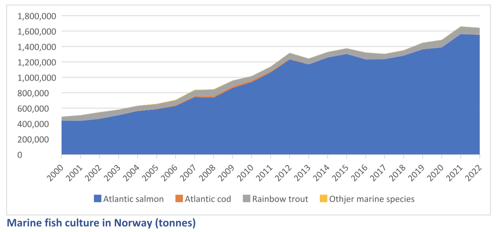Norway is the world's largest producer of farmed salmon, contributing to over half of the global supply in 20222. With its extensive coastline, Norway has established a robust salmon farming industry, primarily using open net pens in coastal areas, with hatchery phases conducted on land through Recirculating Aquaculture Systems.

The country operates under a licensing system where licenses are auctioned, creating significant revenue for the government. However, the current licensing system is nearing full capacity due to environmental and biological constraints, prompting the implementation of regulatory measures to ensure sustainable production,.
The regulatory framework governing Norway's aquaculture is complex, involving multiple public agencies and a mix of old and new laws. The Aquaculture Act of 2005 established a licensing system managed by the Directorate of Fisheries, which oversees the allocation and regulation of licenses. Norway has also introduced a "traffic light system" to manage the Maximum Allowed Biomass (MAB) for salmon farming, allowing for adjustments based on environmental conditions. Additionally, the country has introduced green and development licenses to encourage innovation and environmental compliance, although the regulatory system is currently under review to simplify and streamline operations.
Environmental impacts and the industry's social license are critical concerns in Norwegian salmon farming. Sea lice management is a significant factor in determining production levels, with strict conditions imposed on farmers to control lice populations. The industry has seen a decline in chemical
Environmental impacts and the industry's social license are critical concerns in Norwegian salmon farming. Sea lice management is a significant factor in determining production levels, with strict conditions imposed on farmers to control lice populations. The industry has seen a decline in chemical pesticide use, shifting towards non-chemical alternatives. Moreover, Norway closely monitors environmental impacts such as waste, plastic use, and wildlife interactions, while also addressing socio-economic factors, including employment and contributions to local economies. Despite broad social acceptance, tied to provision of jobs in rural and coastal areas, there is caution about further expansion due to environmental concerns and the introduction of new technologies (e.g. automation) that might threaten employment and provoke resistance from smaller aquaculture players and local communities (Afewerki et a. 2023).
References
-
Norwegian Directorate of Fisheries https://www.fiskeridir.no/English
-
Aquaculture Act 2005 (in Norwegian) (https://lovdata.no/dokument/NL/lov/2005-06-17-79
-
Norwegian Food Safety Authority https://www.mattilsynet.no/language/english/
-
Afewerki, S., Osmundsen, T., Olsen, M. S., Størkersen, K. V., Misund, A., & Thorvaldsen, T. (2023). Innovation policy in the Norwegian aquaculture industry: Reshaping aquaculture production innovation networks. Marine Policy, 152, 105624.
This report is taken from a larger benchmarking analysis completed by the UK aquaculture consulting firm MacAlister Elliott & Partners LTD in 2024.

